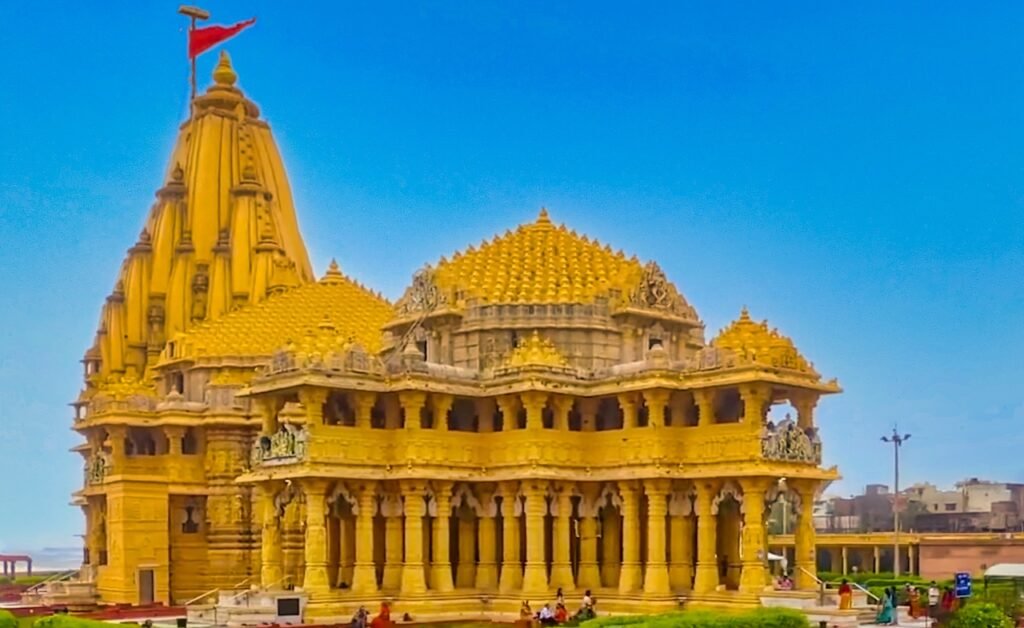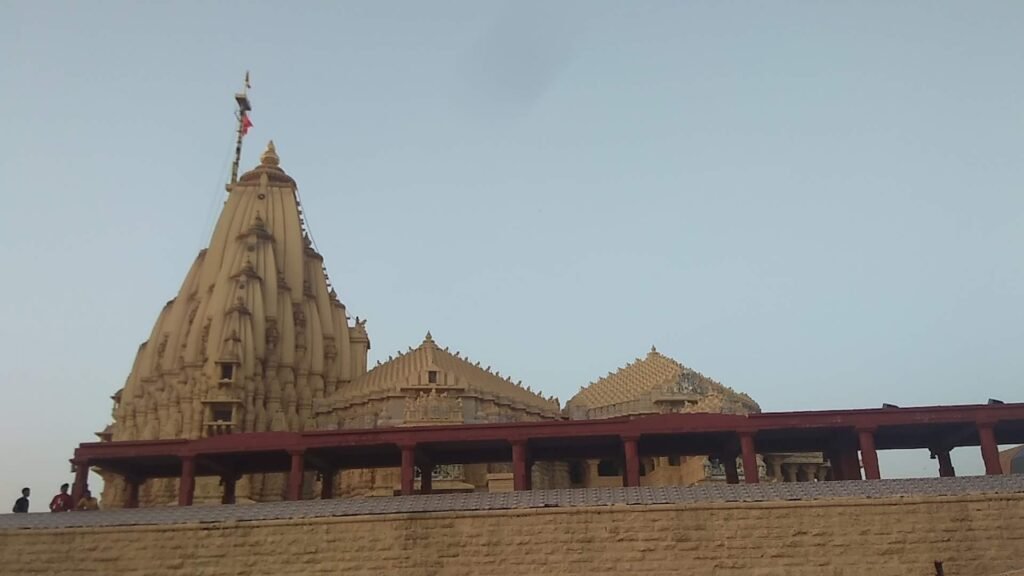The Somnath Temple stands as a symbol of resilience, faith, and artistic brilliance on the western coast of Gujarat. Revered as the “Shrine Eternal,” it weaves a captivating story rooted in legend, history, and spirituality, making it one of India’s most visited pilgrimage sites and a top tourist attraction in 2025.
Overview of Somnath Temple
The Somnath Temple is dedicated to Lord Shiva and is the first of the sacred 12 Jyotirlinga shrines. Nestled in Prabhas Patan near Veraval in the Saurashtra region of Gujarat, it is sometimes called “The Lord of the Moon’s Shrine,” reflecting the legend of Chandra, the Moon God.
- Location: Prabhas Patan, near Veraval port, Gir Somnath district, Gujarat
- Entry Fee: Free for all visitors
- Darshan Timings: 6:00 AM – 10:00 PM every day
- Best Season: October to March for pleasant weather
- Languages: Gujarati, Hindi, and English are widely spoken
Historical Significance
Somnath’s history is a dramatic saga of destruction and reconstruction. The temple, believed to have been first built in ancient times, has been destroyed and rebuilt six times by both invaders and devotees.
- Earliest Mentions: Ancient texts and records mention Somnath as early as the 1st millennium BCE.
- Repeated Destructions: Somnath suffered attacks from 11th-century invader Mahmud of Ghazni, among others, but was rebuilt each time, symbolising indomitable faith.
- Modern Reconstruction: The present structure was completed in 1951, following India’s independence, under the guidance of Sardar Vallabhbhai Patel.
Architectural Marvel
The Somnath Temple boasts Chalukya-style architecture, featuring grand spires, intricate carvings, and sculpted domes.
- Materials: Ancient and current temples used sandstone and intricately carved stone.
- Design Features: Rich engravings, images of deities, and scenes from Hindu mythology are seen throughout the temple complex.
Spiritual and Cultural Significance
The temple serves as a spiritual epicentre, drawing millions of devotees and visitors each year.
- Jyotirlinga: The Somnath Jyotirlinga is a revered ‘self-manifested’ lingam, believed to embody blessings and spiritual energy.
- Legends: Myths suggest the original Shivling floated above the ground due to a mystical stone, symbolising Chandra’s devotion.
- Festivals: Major Hindu festivals, such as Maha Shivratri, Shravan, Karthik Purnima, and Navratri, are celebrated with grandeur here, attracting large crowds and vibrant cultural events.
Somnath as a Tourist Attraction
- Location & Connectivity:
- On-site Amenities:
- Cloakrooms for valuables and electronics (mobiles, cameras, and laptops are not allowed).
- Special wheelchair and lift access for seniors and individuals with disabilities.
- Guided tours and the Tirth Darshan Bus take tourists to nearby temples and historical sites.
- Modern lodging options range from affordable dharamshalas to luxury hotels.

Revenue and Economic Impact
Somnath Temple is a crucial contributor to Gujarat’s tourism revenue.
- Pilgrim and Tourist Numbers: Annually, it attracts millions, making it a pivotal driver for the local economy.
- Associated industries, including local hospitality, transport, and handicraft sectors, flourish due to temple tourism.
How to Reach Somnath Temple
- By Air: The nearest airport is Diu Airport (85 km); Rajkot Airport is approximately 200 km away.
- By Rail: Veraval Railway Station is about 7 km from the temple and is connected to major cities.
- By Road: Well-maintained highways connect Somnath to cities such as Ahmedabad, Rajkot, and Junagadh.
Nearby Attractions
- Bhalka Tirth: The revered spot where Lord Krishna is believed to have left his earthly form.
- Triveni Sangam: The confluence of three sacred rivers – Hiran, Kapila, and Saraswati.
- Junagadh & Gir National Park: A historical city and a wildlife sanctuary for Asiatic lions.
- Somnath Beach: A tranquil shoreline adjacent to the temple, perfect for relaxing post-darshan strolls.
Key Highlights
- Light & Sound Show: An engaging evening program narrates the history and legends of Somnath.
- Poojas & Rituals: Rudrabhishek, Atirudra, Lagurudra, and Navagraha Jaaps are performed, along with large-scale yajnas during festivals.
- Temple Trust Services: The Shree Somnath Trust administers the temple and welfare activities, ensuring smooth facilities for visitors.
FAQs about Somnath Temple
What are the temple’s opening and closing timings?
The temple opens at 6 AM and closes at 10 PM. Regular aartis take place at 7:00 AM, 12:00 PM, and 7:00 PM.
Is the temple open to non-Hindus?
Non-Hindus may visit but must obtain prior permission from the General Manager’s Office.
Are mobile phones and cameras allowed?
No, electronic devices are strictly prohibited inside the temple. Secure lockers are provided free of cost.
Are special facilities available for people with disabilities and senior citizens?
Yes, wheelchairs and lifts are available at the temple entrance.
How can one reach the Somnath Temple?
Somnath is accessible by train from Veraval, by air from Diu and Rajkot, and is well-connected by roads from major cities.
Is there any dress code for visiting the temple?
While there is no strict dress code, we recommend modest and traditional attire for all visitors.
What rituals or poojas are conducted at the temple?
Several poojas, including Rudrabhishek, Atirudra, Lagurudra, and various abhishekams, are performed daily and on request.
When is the best time to visit Somnath Temple?
The months from October to March offer cool, pleasant weather ideal for pilgrimage activities and sightseeing.
Does the temple provide online darshan?
Yes, devotees can avail online darshan and make donations through the official website.
What are the accommodation options available?
From temple-managed guesthouses and economical dharamshalas to comfortable hotels, a range of options is available for all budgets.
Modern Developments and Digital Initiatives
- Digital Donations & e-Darshan: The temple trust facilitates digital offerings, live broadcasts for darshan, and online event booking to enhance visitor experience in 2025.
- Improved Transportation: Enhanced rail and road links provide better access and comfort for international and interstate tourists.
In Popular Culture
Somnath Temple’s powerful story, imposing architecture, and oceanfront location make it an inspiration in literature, film, and Indian memorials. Its repeated reconstruction stands as a metaphor for hope and cultural endurance.
